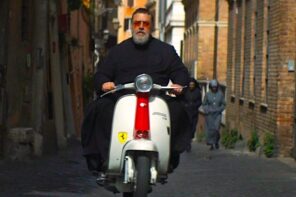Yesterday’s rededication of the Roman Catholic Archdiocese of Boston’s Holocaust-memorial menorah comes at a particularly sticky moment in Catholic-Jewish relations. And that’s precisely the point.
The Diocese had to move recently from its sprawling Boston campus to an office park in the southern suburb of Braintree, selling off the old property to compensate the victims of the clergy sex-abuse scandal. Then the menorah, a replica of the one placed at the North American College in Vatican City in 1999, a symbol of improving ties between the two faith traditions, came along. A four-foot bronze structure, its six candlesticks (scaled down from the seven of the ancient Temple) are held aloft by depictions of disheveled, skeletal figures, each one representing a million murdered Jews.
The Catholic-Jewish détente began with Nostra Aetate, the 1965 Vatican Two document that essentially exonerated the Jews of deicide, and affirmed the validity of the living Jewish tradition. The Vatican’s 1999 release of “We Remember: Reflections on the Holocaust,” an apology for Catholic inaction in response to the Nazis, though criticized by many Jewish authorities as inadequate, was another watershed moment. However imperfect, these moves represented an unprecedented new direction, predicated in part on the fact that, after the genocide of one third of the global Jewish population, it was time for the Church to admit it had a problem. (This explains the centrality of the Holocaust—which Church officials, with a dogmatic sensitivity, refer to by the Hebrew term “Shoah”—in Catholic-Jewish dialogue, Jewish guilt in the murder of Christ seemed fairly non-negotiable till the advent of an equal and opposite cataclysm.)
But there have been a spate of complications recently, stemming mainly from the hardline positions of Pope Benedict XVI. The pope’s decision, last year, to broaden the availability of the Latin rite, including the Good Friday “Prayer for the Conversion of the Jews,” caused a firestorm. The seemingly relentless march of Pope Piux XII toward sainthood, despite his Holocaust-era quietism, continues to ruffle Jewish feathers. (This is a metaphor. We don’t have feathers.) And, most recently, the reinvestment of Lefebvrist bishop Richard Williamson, a delusional anti-Semite, though since moderated in a rare admission of papal fallibility, provoked ongoing aggravation.
All of these events should fundamentally be understood as part of the pope’s efforts to reassert conservatism within the Church, and not as part of a plot to antagonize the Jews. Nonetheless, they have had that effect.
If not for this furor, the menorah might have taken up its new residence like any other piece of transplanted furniture. Instead, it was treated to a somber and effective ceremony, complete with Catholic dignitaries and Jewish survivors (one of whom made his displeasure over the Williamson affair abundantly clear—“He says no Jews died in the Holocaust. Ask him to tell me where my mother and father are.”) The candles were lit, and a cantor chanted el malei rahamim, the traditional prayer for the repose of Jewish souls. A row of cameramen and photographers took images, and reporters filed stories with the international press.




